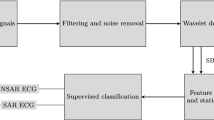Abstract
Paradoxical splitting occurs when pulmonic valve (P2) closes before the aortic valve (A2). This causes second heart sound (S2) to be a single sound during inspiration and split during exhalation. Etiology delay in aortic closure: aortic stenosis, volume overload of left ventricle (LV), conduction defects in LV, and left bundle branch block (LBBB). In this article, a method was proposed in early detection of a reverse in the appearance of A2 and P2 within S2. This method is based on the time–frequency maps obtained with the continuous wavelet transform (CWT), namely, the Meyer wavelet. A number of patients with LBBB and others with fitted pacemakers were studied. The above method is combined with the support vector machine (SVM) and performance of this method is evaluated using classification accuracy (Ca), sensitivity (Se), specificity, positive, and negative predicted values. Results show that it is relatively easy to detect the reverse in A2 and P2 and the Ca and Se is 90.97 and 94.44%, respectively, for the sample of 42 patients whose data were collected from the Cardiology Department at Brighton and Sussex University Hospital in England.



Similar content being viewed by others
References
Al-Naami B, Chebil J, Trabsheh B, Mgdob H (2006) Developing custom signal processing algorithm with lab view FPGA and compact RIO to detect the aortic stenosis disease. Proc―Int Conf―IEEE Comput Cardiol 33:193–196
Al-Naami B (2006) Identification of the paradoxical splitting of the second heart sound using the continuous wavelet transform. Res J Appl Sci 1(1):106–109
Balster D, Chan D (1997) Digital acoustic analysis of precordial innocent versus ventricular septal defect murmurs in children. Am J Cardiol 79:1552–1555
Bentley PM, McDonnell JTE (1994) Wavelet transforms: an introduction. Electron Commun Eng J 6(4):175–186. doi:10.1049/ecej:19940401
Bentley PM, McDonnell JTE (1994) Analysis of heart sounds using the wavelet transform. Proc―16th Int Conf―IEEE/EMBS 2:1304–1305
Bentley PM, McDonnell JTE, Grant PM (1998) Time-frequency and time-scale techniques for the classification of native and bioprosthetic heart valve sounds. IEEE Trans Biomed Eng 45(1):125–128
Comak E, Polat K, Gunes S, Arslan A (2007) A new medical decision making system: least square support vector machine (LSSVM) with fuzzy weighting pre-processing. Expert Syst Appl 32(2):409–414
Cortes C, Vapnik V (1995) Support vector networks. Mach Learn 20(3):273–297
Coubes JM, Grossmann A, Tchanmitchian Ph (1989) Wavelet time–frequency methods and phase space. Springer, IPTI, Berlin
Feigenil LP (1971) Physical characteristics of sound and hearing. Am J Cardiol 28(2):130–133
Goupillan P, Grossmann A, Morlet J (1984/1985) Cycle-octave and related transform in seismics signal analysis. Geoexploration 23:85–102
Gupta CN, Palaniappan R, Swaminathan S, Krishnan SM (2007) Neural network classification of hormomorphic segmented heart sounds. Appl Soft Comput 7(1):286–297
Huang CL, Wang CJ (2006) A GA-based feature selection and parameters optimization for support vector machines. Expert Syst Appl 31(2):231–240
Hugonnet C, Walder P (1998) Stereophonic sound recording: theory and practice. Wiley, USA
Khadra L, El-Asir B, Mawagdeh S (1991) The wavelet transform and its applications to phonocardiogram signal analysis. Med Inform 16:271–277
Kohavi R, Provost F (1998) Glossary of terms. Editorial for the special issue on Appl Mach Learn knowl Discov Proc 30(2–3)
Leatham A (1987) Auscultation and phonocardiography: personal view of the past 40 years. Heart J 57(B2)
Liang H, Lukkarinen S, Haritmo I (1997) A heart sound segmentation algorithm using wavelet decomposition and reconstruction. Proceedings―19th international conference―IEEE/EMBS, Chicago, IL, USA, vol 4, pp 1630–1633
Luisada AA (1971) The second heart sound in normal and abnormal conditions. Am J cardiol 28(2):150–161
Meyer, Y. (1990) Ondelettes et Opérateurs. Tome1, Herrmann, Paris
Obaidat MS (1993) Phonocardiogram signal analysis: techniques and performance comparison. J Med Eng Technol 17:221–227
Polat K, Gunes S, Arslan A (2008) A cascade learning system for classification of diabetes disease: generalized discriminant analysis and least square support vector machine. Expert Syst Appl 34(1):482–487
Rangayyan RM, Lehner RJ (1988) Phonocardiogram signal processing: a review. CRC Crit Rev Biomed Eng 15(3):211–236
Samjin C (2008) Detection of valvular heart disorders using wavelet packet decomposition and support vector machine. Expert Syst Appl 35(4):1679–1687
Swanton RH (1994) Cardiology, 3rd edn. Blackwell, Boston, USA, p 500
Taner T, Hüseyin P, İnan G (2008) Software development for the analysis of heart beat sounds with LabVIEW in diagnosis of cardiovascular disease. J Med Syst 32:409–421
Tilkian G, Conover MB (2001) Understanding heart sounds and murmurs with the introduction to lung sounds, 4 editions. Saunders, USA, pp 9–72
Tovar-Corona B, Torry JN (1998) Time-frequency representation of systolic murmurs using wavelets. Proceedings―international conference―IEEE computers in cardiology, Cleveland, USA, vol 25, pp 601–604
Vapnik V (1995) The nature of statistical learning theory. Springer, New York
Wu CH, Tzeng GH, Goo YJ, Fang WC (2007) A real-valued genetic algorithm to optimize the parameters of support vector machine for predicting bankruptcy. Expert Syst Appl 32(2):397–408. doi:10.1016/j.eswa.2005.12.008
Zhong W, He J, Harrison R, Tai PC, Pan Y (2007) Clustering support vector machines for protein local structure prediction. Expert Syst Appl 32(2):518–526
Author information
Authors and Affiliations
Corresponding author
Rights and permissions
About this article
Cite this article
Al-Naami, B., Al-Nabulsi, J., Amasha, H. et al. Utilizing wavelet transform and support vector machine for detection of the paradoxical splitting in the second heart sound. Med Biol Eng Comput 48, 177–184 (2010). https://doi.org/10.1007/s11517-009-0548-7
Received:
Accepted:
Published:
Issue Date:
DOI: https://doi.org/10.1007/s11517-009-0548-7




